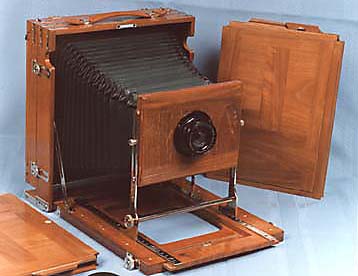
Pictures and brief descriptions for the following
cameras:
This beautifully finished Ica 18 by 24 cm camera, in polished walnut with
german silver fittings, appears to date from about 1927. The camera has
the "Ica" logo, but the original box is marked "Zeiss-Ikon".
The lens shown here is a shutterless Goerz Weitwinkel Lynkeioskop 180/16
- a wide-angle version of the rapid rectilinear design. Three matching walnut
plate holders are designed to hold plates or film in 18 by 24, 13 by 18
and 9 by 12 cm sizes. The green cloth bellows carries black leather corner
reinforcements.
In the years 1928 to 1930, Leitz made a very few (180) Model I cameras
with a colored calfskin leather body covering rather than the usual black
'vulcanite'. These cameras are in effect a lesser variant of the gold-plated
Leica "Luxus". Few Calfskin cameras seem to have survived. If
the camera shown above (Nr. 40330) is representative of most calfskin cameras,
it may hold the explanation. The lens is mounted on top of the leather body
covering. With age and changes in humidity, the lens would become loose,
and tightening the mounting screws would put the lens out of focus! As a
result, cameras would either fall into disuse or be converted to a standard
model. The calfskin on this camera was originally a light brown, but it
has darkened considerably with age and use. You can find a document with
more information about this camera here.
Here's another cute Leica I, but I doubt the chrome and body covering are original Leitz. Nevertheless there does exist are reportedly genuine chrome Leica I - a presentation camera to Drs. Frederick Banting and Charles Best, discoverers of insulin. The conversion from fixed-mount Model A to standardized thread-mount Model C is, on the other hand, a relatively common Leitz conversion. The lens finish here is the original nickel. The lens bears no serial number: the normal case for these conversions.
In 1949 Leitz New York offered this version of the IIIc. For $79 more
than the price of two standard IIIc cameras, one could have the two married
like this! One winds both cameras using the enlarged wind knob on the lower
camera. Both shutters trip when the upper shutter release is pressed. Setting
the shutter speed on the lower camera is a bit of a pain! The cameras must
be unclipped from one another, the speed changed, and the cameras re-joined.
The example pictured above offers another oddity: both cameras have the
'sharkskin' pattern vulcanite body covering, but the grain of the pattern
is vertical on the upper camera and horizontal on the lower camera! This
tandem camera arrangement could be used as a stereo camera, but equally
well two different lenses could be used. The example here utilizes a 35/3.5
Summaron on the top camera and a 50/3.5 Elmar on the bottom. And you thought
changing film on a normal screw-mount Leica was a chore! More information
is contained in an article "Just a Leica Seeing Double" in the
LHSA Viewfinder, Vol 30 No 3 (3rd Quarter 1997) pages 15-17. A similar article,
"Double Vision Leica Style", was published in Shutterbug,
June 1998, pages 226-227.
The View-Master Mk II is unusual in that the film passes through the camera
at an angle in order to pack stereo-pairs in an efficient manner. Also unusual
is the wind plunger: push it down to wind the film; it pops up when you
take the picture. More information about this camera may be found on the
3D-Web.
This Minolta 40-80 mm f/2.8 zoom lens is unusual in several respects:
the zoom controls are located on the side, it is relatively fast and compact,
and it is a unit-focusing lens. A unit-focusing lens extends as a whole
towards and away from the film in order to focus. This is quite normal for
fixed focal length lenses but very unusual for zooms. Most zooms focus by
changing the focal length of the lens or by a combination of changing the
focal length of and extending the lens. On this lens, the wheel controls
the focus while focal length is adjusted by the lever. This particular XD
body is also unusual in that it was sold through Sears in North America,
complete with XD-7 instruction book, as an XD-11.
The Mamiya 6 of the late 1940s and early 1950s was a good quality 120
roll film camera from Japan. Its most unusual feature is the fact that the
lens standard is fixed; focusing is accomplished by moving the Film Plane!
(Rather like the Contax AX of today.) In order to load film, the film pressure
plate must be removed, the film threaded through a frame and the pressure
plate replaced. Focusing is accomplished via the serrated wheel on the back
of the camera and is assisted by a coupled rangefinder. The distance scale
(with depth-of-field indication) is on the top right of the camera. A red
signal in the viewfinder warns if a double exposure is possible. Flash synchronization
is accomplished by a switch operated by the shutter cocking lever. The 75
mm f/3.5 lens is by Olympus. The "PLEASANT AUTO-UP" adapter permits
rangefinder-coupled focusing in the 50 cm to 1 m range.
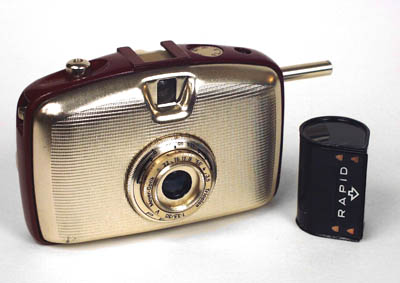
Dressed in gold-anodized aluminum, the Welta "Penti" is from that odd breed of "Rapid Cassette" cameras. Film is moved from one cassette of the type shown to another. After the shutter is released the rod pops out from the left side of the camera, advancing the film by spring power. Pushing the rod back in cocks the shutter and tensions the film transport spring. The camera may be found in other colours also. Format is 18 by 24 mm.
The Voigtlander Prominent (shown at bottom left with 50/1.5 Nokton lens)
was the most sophisticated of the behind-the-lens leaf-shuttered cameras,
and the only one to my knowledge to permit the use of a reflex attachment.
The reflex attachment is more complex than similar devices for cameras with
focal plane shutters. The rear group of the lens must be very close to the
leaf shutter if the shutter is not to cause vignetting. This means the reflex
mirror must be between the front and rear groups of the lens. In turn, this
means that there must be TWO rear groups for the lens: one for the film
and another for the ground glass focusing screen! The mirror in this unit
slides sideways, rather than flip up. Voigtlander thoughtfully provided
three ways to frame the scene: look down at the screen using the direct
vision magnifier (top left), flip the magnifier 90 degrees to show frame
lines for a direct view of the scene (top right, requires keeping both eyes
open) or use the 45 degree prism finder (bottom right). The optical arrangement
necessitates less-than-optimal front group focusing for the lens. For all
the complexity, this lens is limited to focus no closer than 6.5 feet! One
can use close-up lenses, of course.
This mahogany and brass camera by Gilles Faller of Paris demonstrates very fine craftsmanship. Front rise and fall can be adjusted in two stages by virtue of sliding panels at the front (see lower left). The folding bed is locked in operating position by an inner sliding panel, while another set of slides allows the bed to be extended (see upper right). The double plate holders utilize fully enclosed roller blinds rather than traditional dark slides. Nominally a 13 cm by 18 cm format camera, the plate holders also accommodate 5 in by 7 in film or 10 cm by 15 cm plates. The lens shown here is a Berthiot Stellor No. 8 Serie Ib 300 mm f/4.
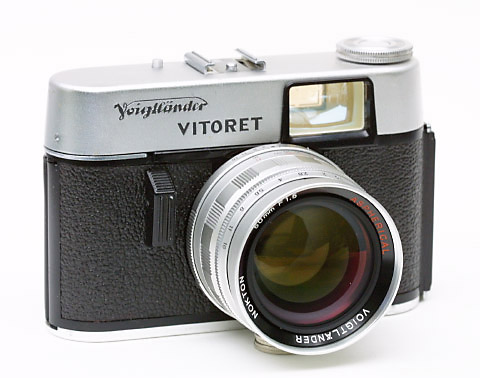
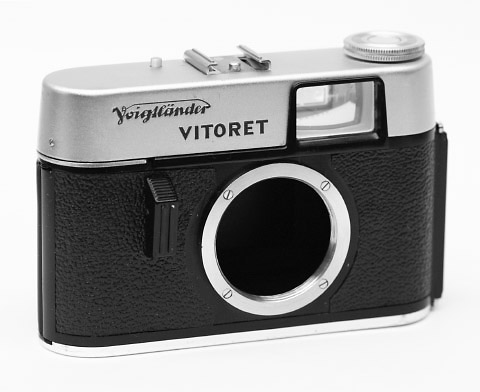
Voigtlander Vitoret Microscope Camera
Until very recently, I thought the earliest Voigtländer camera with a Leica Screw Mount was the Cosina-built Bessa L. But here is an earlier one! Clearly a Vitoret dating from the 1960s. Actually, although it indeed has a Leica thread mount, the mount flange-to-film distance is some 4.5 mm greater than the Leica specification. Thus the modern 50/1.5 Nokton shown here will not actually focus properly on this camera. The camera also lacks a shutter (and therefore also the flash sync of the original). It is almost certaily intended as a microscope camera.
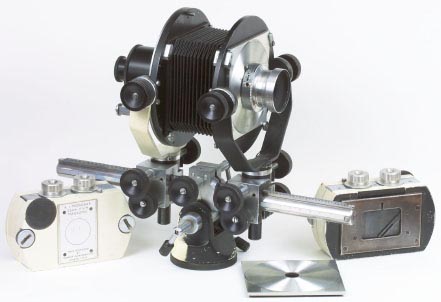
The Kennedy Instruments Monobar is probably the only commercially produced 35mm view camera. It is shown here with two film cassettes and a spare lens panel. The camera has all the normal view camera movements except shift - but shift can be accomplished with swings. The front-facing portions of this camera have been painted black - presumably to reduce visibility of the camera in reflections.
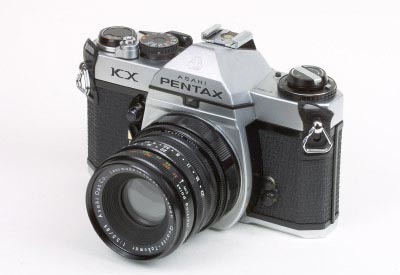
There's nothing much special about a Pentax KX per se, but this is the unusual version with a data back. There were actually two sub-variants of this model, one with an external "sync cord" from the back to the front x-sync terminal, and this one with an internal connection. The lens is also unusual: a quartz lens intended for photography with ultra-violet light. The lens is actually in screw-mount; the body here is fitted with a K-to-screw adapter.
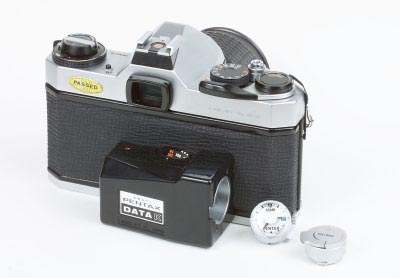
Here's a rear view of the camera showing the databack and two inserts: one being a watch to show the time at the instant of exposure, and the other a simple pad for hand-prepared data. (One must choose one or the other.) This is not simply a databack on an otherwise normal KX; rather the body has been modified to block the image where the data will appear, and to trigger a small internal flash used to illuminate the data. (Yes, that's a different lens in this photo: a 120/2.8.)
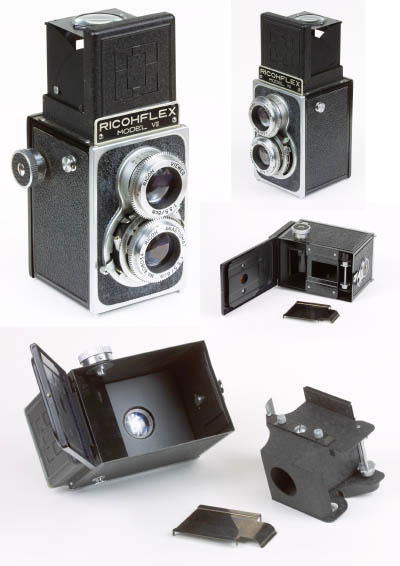
Outwardly, this looks like a standard 6x6 cm twin lens reflex Ricohflex VII. But the wind knob is a bit different and the leather case (not shown) says "For 35MM FILM". Inside, instead of the insert for 120 roll film, we find an insert for 35mm film. There's no facility for rewinding, so I presume this is intended for cassette to cassette operation. The ground glass is marked for the standard 35mm format. There is an automatic wind stop for advancing the 35mm film, but absolutely no interlock between shutter release and wind operations, so multiple exposures and blanks are quite possible. Curiously, the body itself carries no index mark for the exposure counter, but the leather case does.
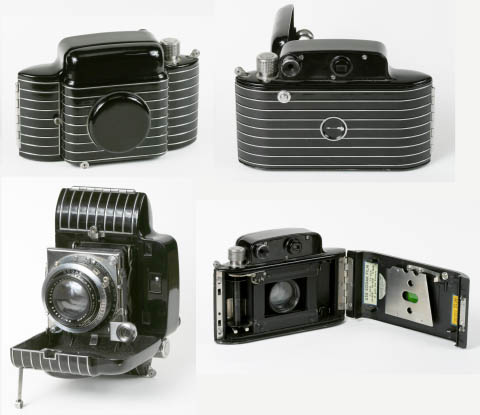
Kodak was not convinced that 35mm film would catch on with the general public and so came up with 828 roll film to fill the needs of the every-day photographer wishing to produce Kodachrome slides. Several models of the Bantam were produced, but the top of the line was this "Special" designed by Walter Dorwin Teague. This is no bakelite cheapy; the body is precision cast, machined and enamelled alloy. Equipped with the high quality 45 mm f/2 Ektar lens, the original selling price was around $110, though this was later reduced to about $90. It is claimed, however, that for about a decade after production ceased in 1947, used Bantam Specials sold for more than their original selling price. It was a true high quality 'rangefinder 35', except that it didn't use the normal version of 35 mm film. Rather, the 828 roll format used 35mm stock with different perforations and permitted only 8 exposures of 28x40 mm dimensions. The "Special" is also a masterpiece of Art Deco design! Two different shutters were used: Compur Rapid 1 sec to 1/500 sec until the US entered WWII, then a Kodak Supermatic of similar specifications but with a top speed of 1/400 sec.
Return to Top of Page.
Return to HM Books Table of Contents
Return to Camera Collecting page.